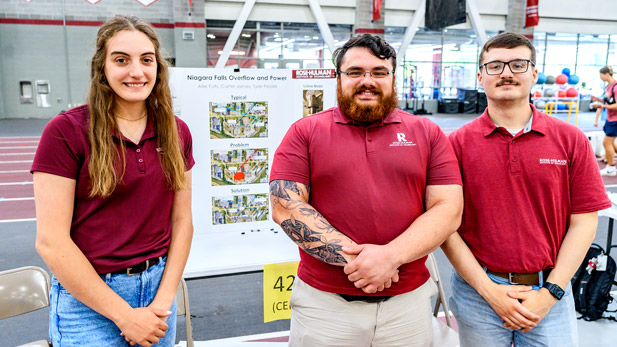Civil & Environmental Engineering Senior Projects Impact Communities Across the Globe

Civil engineering seniors Allie Fults, Tyler Pessler, and Carter James designed a community improvement project for Niagara Falls, New York – among several real-world projects completed by teams within the department last year.
This year’s capstone projects provided civil and environmental engineering seniors with unique real-world work experiences that designed new structural developments and addressed stormwater and wastewater management issues – potentially impacting areas from Niagara Falls to San Francisco, across Indiana, and as far away as Ghana and Nepal.
Teams of students applied the knowledge and skills they have acquired in coursework to help address the needs of an outside client. Along the way they develop critical thinking and teamwork to identify problems, develop and execute a project plan, and clearly present their findings.
For the Port of San Francisco, multiple designs were developed by Sydney Craft, Bradley Harden, Bailey Johnson, and Santiago Lopez of the current 1,600-foot-long steel sheet pile seawall that’s part of the Pier 96 Seawall replacement project. The team’s design addresses the current flooding, settlement, and corrosion issues but also includes a plan for both future industrial operations on the pier. The site and its seawall are in desperate need of redesign due to the rising sea levels, corrosion, and seismic activity.
A 100-foot culvert project and an energy dissipation system for a wastewater treatment facility were designed by Allie Fults, Carter James, and Tyler Pessler that could benefit government officials and residents of Niagara Falls, New York. Its water board sought cost-effective measures that would keep heavy storm flooding conditions from endangering the treatment plant and several nearby homes. A proposed turbine would generate electricity and provide economic benefits by making the plant less reliant on the power grid.
Elsewhere, officials in Huntington, Indiana, sought Brandon Green, Sara Leahy, and Zoe Sterr to design a natural water community swimming pool which uses biofilters in a regenerative basin rather than chlorine to maintain water quality. The team also designed an extension to a pool’s parking lot and renovations to the bathroom facilities, including the addition of outdoor showers.
Improvements to White Pine Manor’s picturesque, affordable, and scenic event space just south of Brazil, Indiana, were created by Kaleb Adams, Ben Brown, Sam Lowrance, and Jake McRoberts. The facility is currently used primarily as a site for hosting weddings. The team’s design of multiple on-site developments could make White Pine Manor a more desirable destination for more events. (The project received Red Ribbon department honors at this year’s Rose Show.)
International projects included design of the Boankra Integrated Logistics Terminal by Nathan Andrews, Will Lawton, Grayson Lincoln, and Mira Randolph for the Ghana Ports and Harbor Authority. The team’s design featured a commercial warehouse, road network, drainage and water supply networks, and waste management considerations.
A proposed Chitwan Hotel Project in Nepal, featuring a 15- to 18-level high mixed-use structure for retail businesses and 150 hotel rooms, was designed by Aaliyah Briggs, Kyra Hicks, Tyler Sommer, and Kate Wood. The building would become the tallest structure in the area, further enhance economic development, and become a community landmark.
Closer to Rose-Hulman, expansion of Miss Softball America’s sports facilities in Terre Haute were planned by Joey Bueno, Peter Jacob, Makayla Ray, and Devin Rayl. The proposed design includes a two-story concession stand, three new softball diamonds, layout of a new restroom and batting facility, improved parking and walkways, and development of stormwater management and wastewater management systems. A retaining wall will increase safety and longevity of the site’s facilities.
Meanwhile, expanded facilities were designed for the Riley (Indiana) Recreation League by Jakey Ovanic, Julius Salinas, Isaac Wanninger, and Zach Zbonski. The team’s plans call for an additional 16 acres to construct several new facilities: three T-ball baseball fields, two Little League fields, a larger Babe Ruth League field, a concession stand and press box, batting barn, conference room, and restrooms. There are also plans to improve parking and transportation accessibility to all league facilities, and better manage stormwater runoff.
A transportation improvement project for Terre Haute’s historic Twelve Points neighborhood was completed by Lucas Chesney and Christian Meyer. The plans include street/path designs for better ease of travel for pedestrians and cyclists from the neighborhood to the nearby Indiana State University campus. There’s also a redesign of a heavily congested intersection that brings together three city streets, and design of additional stormwater management features that could reduce standing water in this section of the neighborhood.
Associate professor Jennifer Mueller, PhD, coordinated this year’s senior-year capstone projects. Other faculty serving as project mentors were John Aidoo, PhD; Kevin Collins, PhD; Jim Hanson, PhD; Kyle Kershaw, PhD; Matt Lovell, PhD; Michelle Marincel Payne, PhD; and Namita Shrestha, PhD; and Kevin Sutterer, PhD.